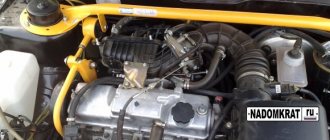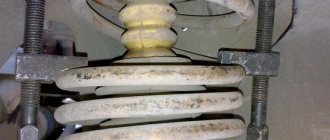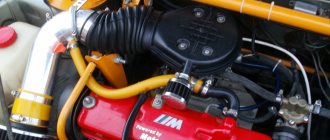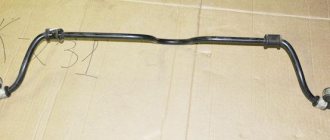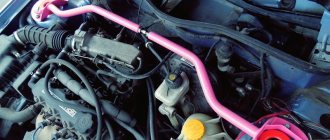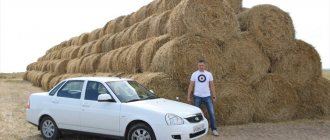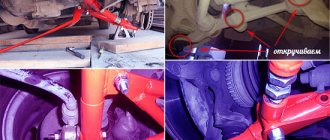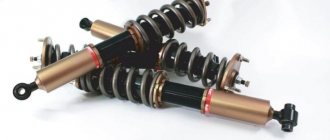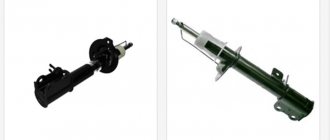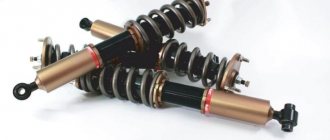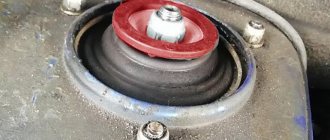The front struts of the Lada Priora are replaced if they fail. Signs of a faulty front strut are most often: dull knocks, squeaks and clicks that occur when the car is moving on an uneven road and come from under the wheel arches.
It is quite difficult and incorrect to make a final conclusion that your car needs to replace the front struts based on knocks alone. For example, a knock in the front lower part may come from faulty ball or silent blocks that need urgent replacement. Simply put, you need to independently diagnose the suspension, steering rods, ball joints and ends in order to make sure that the problem is 100% in the front struts.
Today I will tell you how to replace the front struts with your own hands. For this purpose, I have prepared a detailed photo report, which will certainly be useful to you if you decide to carry out this work yourself.
First of all, perform some simple diagnostics to make sure that the cause is in the racks. To do this, grab the shock absorber with your hands and check for any play in its connections, pay attention to oil smudges. A faulty strut usually has traces of oil on the piston and boot. Hang the wheel and repeat the check; the faulty strut will be immediately visible, so I see no point in describing the diagnostic process in detail.
For myself, I chose the Acomi front struts model “Comfort CLASSIC A170.2905.002/003-05”, you can buy others, this, as they say, is the owner’s business.
The main criterion that I was guided by when choosing was softness and affordable cost. I was pretty fed up with the “original oak” racks, so when installing new ones, I decided not to buy a cheap one. Soft struts provide comfort, which is very important while driving; for me, for example, this is almost the most important thing in a car.
Relevant: UPPER SUPPORT OF THE STRUT VAZ 2115 - REPLACING WITH YOUR HANDS
The front struts of Acomi are collapsible, hydraulic, which is quite convenient; if you feel that something is wrong with the struts, you can easily “bring them back to life” by purchasing special cartridges in the store, after which they can be easily installed, “original” SAAZ did not allow this to be done.
Replacing the front struts of a Lada Priora yourself is not an easy task; to say that it is very difficult, it seems not, but it takes quite a lot of time. In addition, if a person does not know what is what, then he can get pretty tired while carrying out this work. Before changing the front struts, you need to acquire a special tool, namely: special tensioning devices for the springs, as well as a puller for unpressing the steering tips.
As for standard tools, to perform this you will need:
- Socket wrenches for “13”, “17”, “19”;
- Spanners for “17”, “19”, “22”;
- Hexagon at "6";
- Pliers and hammer;
- WD-40.
Before starting work, I recommend treating all fasteners that need to be disassembled with WD-40; this is best done a few hours before starting repairs.
practical guide
It is convenient to carry out the work in an inspection ditch. The work is shown on a car with a hatchback body. On a station wagon, the work is performed in the same way. On a sedan car, access to the upper shock absorber mount is through the luggage compartment.
Replace shock absorbers and springs in pairs.
To complete the work you will need:
— inspection ditch or overpass;
— a device for disassembling suspension struts.
We carry out the work with an assistant.
Removal
1. Prepare the car for work and hang the rear of the car on stands.
If there is no inspection ditch or overpass, remove the rear wheel of the car from the side of the shock absorber being replaced.
2. Remove the luggage compartment shelf.
3. Fold down the back seat.
4. In the luggage compartment, use a Phillips screwdriver to remove the four screws securing the upholstery.
5. Use a screwdriver to pry off the trim of the seat back lock.
6. Using a 19 mm wrench, unscrew the lock and remove it.
7. Using a Phillips screwdriver, unscrew the screw securing the luggage compartment lining.
8. Bend down the luggage compartment upholstery.
9. Use a Phillips screwdriver to unscrew the top screw securing the cladding.
10. Using a Phillips screwdriver, unscrew the two lower screws securing the cladding.
11. Move down the luggage compartment lining.
12. Using a 13 mm socket wrench, unscrew the two nuts securing the seat back clamp bracket.
13. Remove the retainer bracket.
14. Using a slotted screwdriver, remove the plug.
15. While holding the shock absorber rod from turning with a 6 mm wrench, unscrew its nut with a 17 mm wrench.
16. Use a magnet to remove the spring washer and the upper support washer from the shock absorber rod.
17. Remove the upper rod mounting pad from the shock absorber rod.
18. Using two 19 mm wrenches, unscrew the nut of the bolt securing the lower end of the shock absorber to the rear axle beam and remove the bolt.
19. Move the lower end of the shock absorber towards the rear of the car and remove the shock absorber.
20. Remove the spring and its gasket from the shock absorber, and also, if necessary, remove the lower cushion and spacer from the shock absorber rod.
Installation
Springs of the same class (with the same color marks) should be installed in the rear suspension of the car.
1. Before installing the shock absorber, secure the rubber gasket 4 to the spring 2 with insulating tape or tape.
2. Install the spring on the shock absorber and fully extend the rod. We put a buffer 1, a protective casing 3 with a cover, a spacer sleeve 5 and a lower cushion 6 (if they are not on the rod) onto the shock absorber rod.
When installing, the shock absorber must be oriented so that the end of the lower coil of the spring faces the wheel.
3. We insert the shock absorber rod into the hole in the body cup, at the same time an assistant puts the upper cushion and support washer on the rod and tightens the rod nut a few turns.
4. Raise the lever until the holes in the shock absorber and beam bracket align. Install the lower shock absorber mounting bolt and tighten its nut (without tightening).
If you don't have an assistant, you can first attach the shock absorber to the rear suspension beam. Then, placing a stop under the rear lever, smoothly lower the car on the jack, making sure that the shock absorber rod enters the hole in the body, and after that, put on the upper cushion with the support washer and tighten the nut.
5. Install the removed wheel (if the work was carried out without an inspection ditch) and lower the car onto the wheels. We press the rear of the car several times to self-install the suspension elements.
6. Tighten the shock absorber rod mounting nut to a torque of 50-61.7 Nm (5.1-6.3 kgcm).
7. Tighten the nut of the shock absorber lower mounting bolt to a torque of 66.6–82.3 Nm (6.8–8.4 kgcm).
Replacing a support bearing without wheel alignment
1. Remove the hub cap and unlock the CV joint nut. (My nut was so tight that neither a screwdriver nor any pick could be reached, so I decided to use a drill and a suitable drill bit)
2. Use the head to push the CV joint nut through the wrench until it rotates easily. The assistant presses the brake at this time.
3. Raise the car on a jack and remove the wheel.
4. Unscrew the steering tip nut and unscrew it. Using a hammer and a pry bar, press out the finger.
5. Unscrew the 2 ball mounting bolts and disconnect the ball.
6.Release the brake hose from the strut.
7. Unscrew the 2 caliper bolts, first bending the washer petals. and move the caliper to the side (do not leave it hanging on the brake hose).
8. In order to make it easier to work with it “on your knees” after removing the stand, remove the nut from the stand, but do not unscrew it. Next, unscrew the 3 support nuts.
9. Unscrew the CV joint nut. We take out the rack while simultaneously pulling the CV joint from the splines.
10.Tighten the spring and then unscrew the support bearing.
11. Install a new support. We assemble everything in reverse order.
Don't forget that you need to install a new nut. Tighten and lock with a large torque.
Be careful not to tear off the 3 nuts securing the support, the moment there is small (2 kgf m).
What is not clear, ask!
Lada 2110 2004, petrol engine 1.5 l., 78 l. p., front drive, manual transmission — scheduled maintenance
Cars for sale
Lada 2110, 2005
Lada 2110, 1998
Lada 2110, 2002
Lada 2110, 2006
Comments 100
Please tell me, the nut on the stand has loosened, the rod has started to pull and is turning. As I understand it, you need a special key. Question: is it okay if the rod turns?
Hello, it's okay that he turned around.
Toe-in is necessary if the steering rod (tip) is twisted or changed. always the struts (springs, support) were changed without adjustment
When you replace the strut, the camber will go away!
Toe-in is necessary if the steering rod (tip) is twisted or changed. always the struts (springs, support) were changed without adjustment
This is not new; I managed to change the support without removing the spring, compressing it on the strut!
THERE IS NOTHING BETTER THAN SS20 SUPPORTS, I HAVE OVER 200K, THE MAIN MAIN THING IS NOT TO RUNS INTO A FAKE
You can argue about this for a long time, while I was choosing what to use, I was considering these two options, but for me everything weighed in favor of Asomi and I still consider them the best and most comfortable.
I WENT TO ASOMI, THERE WERE SHOCK MORTS AND SUPPORTERS, EVERYTHING DIE AFTER 40 THOUSAND KM, but you try SS20 preferably highway, in my opinion this series has the best characteristics
I also had an Acomi on gas meat after 50 thousand, one side of the bearing was squeezed out
I WENT TO ASOMI, THERE WERE SHOCK MORTS AND SUPPORTERS, EVERYTHING DIE AFTER 40 THOUSAND KM, but you try SS20 preferably highway, in my opinion this series has the best characteristics
About the ss20 supports, yes, that’s a thing, but the ss20 supports, although they last a long time, are because they don’t work as supports, they are gear crushers. Ps, but I still drive the ss20)) “eternal” ones, and my props died quickly, apparently because of the track.
they are stiffer than the original ones, but this is closer to a sports suspension; in my experience, a VAZ2115 on SS20 struts at a speed of 90-100 km per hour does not notice the open hatch at all, and on regular struts, at least you will bend the wheels and at most you can get killed
It’s tough as you are with the steering tip, and the plastic in it will all crack ((((
Why, I loaded the rod with an assembly and hit the bipod from the end, that’s it, nothing will crack there, there is no large load on the steering tip.
Well, then they use a puller to press on the part where the nut should turn)
improvised means. A shirt remover probably costs 500.
The other day I had a chance to talk with a friend - his chain on a SsangYong Action jumped, so he said that when he was studying this issue, he had the opportunity to meet one “Kulibin”, who changes the chain by pulling with partial disassembly of the engine, he got so used to it that his record is 37 minutes and charges about 7 thousand rubles for this.
It would seem: - 7 thousand per hour - immodest...
But if you compare with any other OD masters who take no less than half a day to do the same thing and the prices are about 35...40 thousand rubles...
Shock absorber manufacturing plants
There is a huge selection of companies that are better at producing these parts for Priora. And all of them are highly appreciated by our car owners.
- Koyaba;
- Horses;
- Monroe;
- SS20;
- SAAZ.
If the first three companies are foreign manufacturers, then SAAZ and SS20 are purely domestic enterprises. Moreover, SS20 is named so because most of the engineering employees of this company previously worked in the defense industry, and as you know, those who understand their business best have always worked there. And in honor of the famous missile system, which is distinguished by its amazing reliability, the enterprise was named.
Two and one tube shock absorbers
There is also a division of these unevenness compensators according to one more characteristic. These are the so-called two-pipe and single-pipe devices. From the name it is clear that “pipes” are cylinders filled with a compensating composition. In the single-pipe version, this is the same “syringe” in which the rod with the piston moves. In a two-pipe system, the role of the rod is played by a second, hollow cylinder inserted inside the first, which has a valve system at the end for better movement of the compensating material.
Typically, single-pipe systems use a single material, gas or oil. But double-pipe struts most often have a double filler and are gas-oil.
Chassis SS20
These spare parts for domestic and foreign cars are produced under the “System Technologies” brand. These racks have become so popular due to their high quality. For Priora, the manufacturer offers 4 product options that differ in hardness. Which stands are better? They need to be selected according to your driving style. The softest ones are the “Standard” series racks. Rear shock absorbers from the same series are also offered.
A reinforced version is offered to increase the load capacity. Next are the “Comfort” racks. According to reviews from many car owners, this is the best option. They are stiffer than the Standard, but the suspension works equally well on bad and good roads.
Rear shock absorbers on Priora
The rear wheels of the Lada Priora factory also come with non-separable shock absorbers. Their characteristics are similar to the front ones. As many drivers note, these shock absorbers are very soft and do not hold the road well at high speeds.
| vendor code | Rod diameter, mm | Case diameter, mm |
| 21702915004 | 11 | 46 |
Analogs of Priora front shock absorbers
Replacements for shock absorbers on the rear wheels of Priors are slightly less popular than those on the front wheels. Often, many drivers install analogues on the front wheels, and leave original spare parts on the rear wheels. Nevertheless, the most popular analogues of rear shock absorbers are presented below.
| Manufacturer | vendor code | price, rub. |
| SS20 | SS20144 | 5200 (set, 2 pcs.) |
| Fenox | A12288C3 | 1200 |
| Kraft | KT 073542 | 1200 |
SS20144
Fenox A12288C3
Kraft KT 073542
Which shock absorber struts for Priora are better? For moderate driving, and at a low price, it is better to take the original SAAZ. Also, shock absorbers from the Russian company SS20 deserve special attention. They produce high-quality and technologically advanced products at a relatively low price. The range is represented by several lines of shock absorbers (differing in level of rigidity). But the most popular for the VAZ 2170 is the “Comfort” series. They are a little stiffer than the factory ones, which is especially noticeable at speeds up to 50 km/h. But after this mark they perfectly reveal their full potential on uneven roads. When entering the pit, the sound is practically inaudible, and most of the vibrational energy is absorbed.
Also of particular interest are shock absorber struts from the Japanese Kayaba (KYB), the big advantage of which is their versatility. They perform well both on smooth highways and off-road. The company has developed gas-oil shock absorbers labeled Exel-G, especially for Priora. But, due to the novelty of these spare parts, they are now quite rare on sale.
Manufacturers and prices of analogues
- A frequently used analogue of Priora struts is the SS-20.
- SS-20 are sporty, they provide greater “strength” of the suspension, and cost accordingly.
- The front part number is SS20118, they cost 6,000 rubles for two pieces. However, there is one “but” - the SS-20 must be installed together with supports that fit the fasteners.
- The price of Priora struts is not that high, because the SS-20 company sells them as a kit. A set of rear shock absorbers costs 5,200 rubles, article number – SS20144. This company has several model lines - standard, sport, comfort, optimal.
- There is an analogue from Trialli: AH-01159 on the left, AH-01360 on the right, the price is 1,900 rubles each. Front shock absorbers at a low price - from Pilenga: SH-P 2771 - O on the left, SH-P 2770 - O on the right. Cost: 1,600 rubles. In terms of replacing rear components, you can take a closer look at Fenox A12288C3 (1,200 rubles) and KraftKT 073542 (1,200 rubles).
- There is an expensive analogue - Kayaba struts for Priora. They are called KYB EXCEL-G (front), the price of the set is 6,000 rubles, the complete rear set will cost about 6,100 rubles.
- An analogue of Demfi is sold under the article number ITM70-2905002, ITM70-2905003, price - 2,100 rubles (front), ITM70-2915004, cost - 1,300 rubles (rear). The model range is quite wide: gas, hydraulic options, and there is an adaptation for a lowering spring. Branded shock absorber mounts for Lada Priora are for sale.
Priora front struts and rear shock absorbers: the best solutions
As practice shows, correctly selected front struts on a Priora can significantly improve the car’s behavior on the road. Taking into account the fact that Lada Priora is a budget model, there is no talk of installing expensive shock absorbers such as Bilstein, Koni, Sachs and others.
Some manufacturers simply do not have struts for Priora, others have solutions that are too expensive, and in some cases, modifications, alterations, etc. will also be required to install a new shock absorber. However, among the more affordable and high-quality racks for Priora, SS20, SAAZ or KYB (Kayaba, Kayaba) can be distinguished.
The main difference is the stiffness of the SS20 shock absorbers. These struts are hydraulic and are available in “standard”, “comfort” and “sport” versions. The manufacturer offers both rear and front struts of the Priora, which allows you to select suitable parts and perform the so-called replacement of struts “in a circle”.
The SS20 “standard” struts are the softest and are well suited for a quiet ride. The “comfort” version is more universal, the shock absorbers are a little stiffer, and are better suited for high-speed driving on the highway. Also, these racks work more efficiently on bad roads.
The SS20 “sport” version is the toughest and is designed for high speeds. At the same time, the car's handling improves noticeably, however, when driving on bad roads, the stiffness of the shock absorbers somewhat affects comfort.
Let’s also add that in addition to the struts, the manufacturer offers the Priora support bearing (SS20 support), bump stops, etc. In practice, supports for Priora and other parts allow you to purchase a kit and replace the racks without any modifications. Also, the supports are considered reinforced, the bumpers withstand impacts well, and the pillars do not break through.
If you need imported racks, in this case it is recommended to pay attention to Kayaba racks (KYB for Priora). The manufacturer from Japan is well known all over the world, and also offers spare parts for Russian-made cars
For the Priora, KYB has developed Exel-G gas-oil shock absorbers. This line includes the front and rear pillars of the Priora. In practice, these shock absorbers are in great demand among car enthusiasts. Kayaba on Priora is considered a universal solution, the rigidity is average (it holds the road well on the highway and performs well in the city).
KYB shock absorbers are also distinguished by their long service life and reliability. The only negative is the rather high price. It should also be noted that when comparing which is better, Kayaba or SS20, often the first option is better.
The SAAZ racks complete the list. Let’s note right away that these are Priora’s standard factory struts. In other words, this Priora shock absorber is on the car from the factory. This option can be taken if the car’s behavior on the original shock absorbers is completely satisfactory.
The price is quite affordable, although the service life of SAAZ shock absorbers on the VAZ 2170 is no more than 40 thousand km. It can also be noted that in some cases you can limit yourself to only replacing the racks themselves, leaving the factory supports and bumpers (if they are fully functional).
Preliminary preparation for replacement
Replacing the shock absorber strut is accompanied by the dismantling of a number of related elements. Troubleshooting them allows you to identify parts with an end of life, so you may need to additionally purchase this or that product.
The service life that the support has is in most cases comparable to replacing the rack. Therefore, experienced car owners recommend purchasing it in advance.
To prevent the need for repeated repairs, it is advisable to replace rubber products. For example, it is recommended to install the boot and bumper new, regardless of the condition of the dismantled elements.
Some car owners perform suspension tuning when replacing the shock absorber strut. One option is to use interturn spacers. This action allows you to increase ground clearance and increase chassis rigidity.
Rear shock absorbers on Priora
The rear wheels of the Lada Priora factory also come with non-separable shock absorbers. Their characteristics are similar to the front ones. As many drivers note, these shock absorbers are very soft and do not hold the road well at high speeds.
| vendor code | Rod diameter, mm | Case diameter, mm |
| 21702915004 | 11 | 46 |
Analogs of Priora front shock absorbers
Replacements for shock absorbers on the rear wheels of Priors are slightly less popular than those on the front wheels. Often, many drivers install analogues on the front wheels, and leave original spare parts on the rear wheels. Nevertheless, the most popular analogues of rear shock absorbers are presented below.
| Manufacturer | vendor code | price, rub. |
| SS20 | SS20144 | 5200 (set, 2 pcs.) |
| Fenox | A12288C3 | 1200 |
| Kraft | KT 073542 | 1200 |
Kraft KT 073542
Which shock absorber struts for Priora are better? For moderate driving, and at a low price, it is better to take the original SAAZ. Also, shock absorbers from the Russian company SS20 deserve special attention. They produce high-quality and technologically advanced products at a relatively low price. The range is represented by several lines of shock absorbers (differing in level of rigidity). But the most popular for the VAZ 2170 is the “Comfort” series. They are a little stiffer than the factory ones, which is especially noticeable at speeds up to 50 km/h. But after this mark they perfectly reveal their full potential on uneven roads. When entering the pit, the sound is practically inaudible, and most of the vibrational energy is absorbed.
Also of particular interest are shock absorber struts from the Japanese Kayaba (KYB), the big advantage of which is their versatility. They perform well both on smooth highways and off-road. The company has developed gas-oil shock absorbers labeled Exel-G, especially for Priora. But, due to the novelty of these spare parts, they are now quite rare on sale.
Uneven tire wear
Increased speed when cornering Practice a more relaxed ride Excessive wear on the ball joints of the suspension arms and silent blocks Repair the front suspension Imbalance of the wheels Rebalance the wheelsNew Lada: On-board computer “State Priora XD” | Samara-Stavr
Let us remind you that another car disease can be called steering rack knock.
Key words: front suspension of Lada Priora
8
Found an error? Select it and press Ctrl Enter..
- AvtoVAZ offers discounts on LADA purchases for SDEK
- Refinement of the shape of the standard Lada Vesta armrest
- BTC: Review of Lada Vesta Sw Cross after 10,000 km
- AvtoVAZ told how it checks the noise of gearboxes at the factory
Basic faults
How to change wipers on a car: step-by-step replacement process
Failures of a part of the Priora suspension can be judged by the following signs:
- Oil leaks under the wheels. The shock absorber consists of a cylinder, valves, a piston with a rod - all parts actively move, so they need lubrication. If there are leaks, it means the device has become depressurized and will work less efficiently.
- Mechanical damage. If possible, visually inspect the parts - if there is any deformation or rust, it means they have “worked their best.”
- Rock the front (and then the back) of the car in different directions - away from you, to the left, to the right. When you release the car, one or two vibrations are considered normal - it is “damped” by a normal shock absorber. If the car stops immediately, the part is jammed; if it continues to wobble, replace it.
- When traveling, the car begins to wobble, the braking distance increases, and when turning, the car wobbles greatly. Also, when driving over speed bumps, or ordinary potholes, broken shock absorbers do not dampen vibrations at all, that is, the car sways as if on waves, and a knock will be heard.
Service station employees check the suspension with a vibration stand or a special stand. The check goes down to small units - they can even tell you how long it will take to approximately replace them.
Dismantling the telescopic stand of the VAZ 2170
You will need: ties for the suspension springs, a 14mm wrench, a 6mm hex wrench, a 22mm socket wrench.
1. Remove the telescopic stand from the vehicle (see “Removing and installing the telescopic stand”).
| 2. Clamp the telescopic stand in a vice, compress the spring with special ties... | 3. ...and unscrew the shock absorber rod nut with a 22mm spanner, holding the shock absorber rod from turning with a 6mm hex wrench. |
| 4. Remove the strut upper support travel limit washer. | 5. Remove the upper strut support assembly with the bearing... |
| 6. ...and the compression stroke limiter of the upper strut support... | 7. ...then remove the spring from the shock absorber strut. |
| 8. Remove the compression stroke buffer and protective casing from the shock absorber rod. | 9. Remove the bearing from the upper strut support... |
| 10. ...upper cup and spring insulating gasket... | 11. ...and then disconnect them. |
| Note Lada Priora cars use a shock absorber strut of a non-demountable design. A failed rack must be replaced. |
| 12. Inspect the telescopic stand parts. | 13. Replace damaged compression stroke buffer and protective cover. |
| 14. Replace the bearing if it moves axially in the support housing or sticks when turning... | 15. ...if signs of rubber aging are detected, replace the upper support. |
| Note Buy parts with markings... |
...on a telescopic stand...
...on the support bearing...
...and on the top support.
16. Replace the spring if cracks are found on it or its coils are deformed. To loosen the spring, press it three times until the coils touch. Then apply a load of 3356 N (342 kgf) to the spring. Compress the spring along the axis of the spring; The supporting surfaces must match the surfaces of the support cups on the telescopic stand. If the length of the spring with brown markings (class A) is less than 230 mm, replace it with a spring with blue markings (class B).
| Note Install springs of the same group on the left and right of the car. Replace springs in pairs. |
17. Assemble the telescopic stand in the reverse order of disassembly. At the same time, place the protective cover on the annular groove of the compression stroke buffer. Install the spring so that its ends rest against the protrusions of the lower and upper cups.
18. Completely tighten the upper shock rod nut with the vehicle on the ground.
Video about “Disassembling the telescopic stand” for VAZ 2170
how to disassemble a prior strut
DIY shock absorber repair
Replacement of front struts, supports and springs of VAZ 2110, 2112, Lada Kalina, Granta, Priora, 2109
To bleed the rack do the following:
Bring the stand to a vertical position, then pull the rod to its highest point and slowly return it to its place.
Repeat these movements 3-4 times. There should be no dips, falls or jamming of the stem. Once bleeding is complete, the posts must be in an upright position before being reinstalled. Bleeding the racks will bring them into working condition.
After this, assemble a new shock absorber, for this you need:
- Set the rack rod to the upper position.
Replacing the front struts of a Lada Priora with your own hands
Replacing the front struts of a Lada Priora with your own hands
- Put on the boot and compression buffer.
- Install the spring, cup and damper.
- Place the smaller washer first, then the larger washer from the kit. After this, you can install the support with the bearing.
- Install the nut that secures the rod.
- Tighten the nut with a hexagon to “6” while holding the rod. The final tightening should be done after the front strut has been installed in the car.
- Remove the zip ties.
Replacing the front struts of a Lada Priora with your own hands
- Turn the support with the pointer forward and slightly inward of the car body.
Replacing the front struts of a Lada Priora with your own hands
- Install a new strut into the car.
- Tighten the upper support bolts and place the strut on the steering knuckle. An eccentric bolt with a washer must be secured in the upper hole, a regular bolt in the lower hole. After that, “stretch” everything.
- Pin the finger.
- Place the brake hoses in the holder bracket on the rack.
Replacing the front struts of a Lada Priora with your own hands
This completes the replacement of the front strut. You just need to put the wheel back in place and remove the jack. As soon as the car is on the ground, you should tighten all the nuts with a wrench until they stop.
Repeat all steps on the other side. This usually does not cause any difficulties.
After replacing the front struts of your Lada Priora, you need to go to a service station and get a wheel alignment done. If you do not do this, problems may arise: the car will sway from side to side.
Why do racks fail?
There may be several reasons for breakdowns. Firstly, do not forget that the unit is a consumable item and must be periodically replaced (approximately every 20 thousand kilometers). Secondly, parts are subject to increased wear due to excessive load, especially in conditions of poor quality, broken roads.
3 popular ways to check the health of a node
The first way is to check for play in the front suspension struts. To do this, you need to remove the front wheel, grab the stabilizer bar with your hand and pull it forcefully
At the same time, pay attention to the presence or absence of play. If it is present (even minor), the product must be replaced
To carry out the second method, you will need a hole. The idea is that one person is in the pit and puts his hand on the stabilizer post. At this time, the second participant is behind the wheel of the car and slowly moves forward and backward. If there are problems with the performance of the stabilizer struts, at the moment the car begins to move, the person in the pit will feel a blow.
"Important! To avoid injury, when carrying out such diagnostics, you should follow safety rules and exercise vigilance and caution.” The third common way is to undergo a complete suspension diagnostic at one of the professional auto diagnostic centers.
The third common way is to undergo a complete suspension diagnostic at one of the professional auto diagnostic centers.
HOW TO CHANGE THE FRONT STRUTS OF A LADA PRIORA - DETAILED INSTRUCTIONS
1. First of all, remove the mounting bolts on the wheel, then install the jack on the side from which you are going to make repairs.
2. Next, unscrew the bolts completely and remove the wheel.
3. It is necessary to disconnect the brake hoses, and then remove them from the holder located on the rack.
4. Take pliers and carefully unscrew the locking cotter pin on the steering end pin, then you need to take it out and unscrew the nut with a “17″ wrench.
5. Now it’s the puller’s turn, install it on the steering end as shown in the photo and press it out of the socket.
6. Unfold the support and start unscrewing the fastening nuts on the steering knuckle. If you followed my recommendations and treated all connections with WD-40, there should be no problems with unscrewing.
7. If necessary, use a hammer to knock out the bolts, being careful not to damage the threads.
8. The top eccentric bolt is used to adjust the camber and has a washer on it that often likes to stick to the strut. Do not throw away the bolt itself; it will be reinstalled during the replacement process. There is no point in remembering the position of the eccentric along the axis, since in any case you will have to go to the wheel alignment.
9. Let's move on. Using a 13" wrench, unscrew the fastening nuts that secure the front strut to the body; they are located under the hood.
10. We take out the front strut from the wheel well assembly.
How to replace them yourself
Replacing the front struts on a Lada Priora with your own hands is quite possible if you make sure you have all the tools and components. You also need to take into account the recommended sequence of actions so that you do not have to overpay when correcting errors.
To carry out this procedure:
- We take the jack and install it on the side where the installation begins.
- We remove the wheel, unscrew the brake connections, take out their fastenings located on the rack.
- We take pliers and carefully unbend the lock on the finger of the steering tip, take it out, and unscrew nut number seventeen.
- We reach the steering tip puller and pull it out.
- Scroll the support and unscrew the steering knuckle nuts. If you used WD-40 before, this will not be difficult to do.
- If this was not possible, but you can’t unscrew it, you can try knocking them out with a hammer. We just act as carefully as possible so as not to damage the thread.
- Next, we take on the eccentric bolt located on top and save it - it is necessary for adjusting the wheel alignment. It is also recommended to remember its location, focusing on static elements.
- All that remains is to unscrew the retaining nuts that secure the structure; access to them is under the hood.
- Now it’s time to remove the assembled structure with the shock absorber from the wheel well.
Replacement of racks is carried out after dismantling the old ones, so we disassemble everything step by step.
Now let's start disassembling the existing structure
1. This is where you will need the previously prepared spring ties. Install them on the second coil (top and bottom) of the spring, as indicated in the picture. We install the second screed in the same way, only on the other side.
2. Now start bringing the spring together; to do this (if anyone doesn’t understand) you need to twist the tie bolts of the first tie. This is done until the second tie begins to move freely on the turns; repeat all of the above in relation to the second tie.
3. Using a “22” socket and a hexagon, unscrew the nut securing the strut rod to the support.
4. Next, remove the bump stop (limiter), as well as the support bearing, compression limiter and support.
5. We replace the old rebound limiter washers with new ones that came with the struts, be careful, they are different - the top one is slightly larger than the bottom one.
6. Remove the spring cup along with the rubber damper, as well as the spring, compression buffer and boot.
Now let's carefully examine the rack.
The cause of the malfunction was discovered almost immediately, after checking the play, I raised the rod to the top point, then simply released it, after which the piston sharply went down without the slightest resistance and “slammed” into the upper part of the cylinder. Here, as they say, no comments... Now it’s clear where the dull knocks were coming from.
Before replacing the front drain, it must be bled.
Replacing front springs
With a sufficiently high mileage of the Priora, its front springs in any case lose their properties and sag over time.
Of course, the work of the suspension with seated springs will not be complete; the front of the car will become even lower, which will negatively affect the work of the entire suspension as a whole. To replace the springs with your own hands, you will need the following tool:
- Spring ties
- Key for 22
- 6 mm hexagon
What are rear struts?
The design and principle of operation of the rear shock absorber struts of the Lada Priora are practically no different from other cars. From the factory, the machine is equipped with SAAZ shock absorbers, which have a two-pipe hydraulic (oil) design.
It provides damping of shock loads due to oil resistance to the piston inside the cylinder. In fact, this design resembles a conventional pump, only oil acts as air.
At the front of the Priora there are also oil struts that work on the same principle. They differ from the rear ones only in the size and design of the body. In addition, the front struts have brackets for attaching tie rod ends.
Oil shock absorbers are quite reliable and durable, and in addition, they provide maximum comfort, as they are considered the softest. However, they also have their drawbacks. The fact is that oil is very susceptible to the influence of temperatures, both high and low. When heated, it becomes too liquid, which causes the shock absorber to “soften” even more.
When exposed to low temperatures, the oil hardens, making the racks as rigid as possible. Naturally, this cannot but affect their condition, and it often happens that after a hot summer or cold winter, shock absorbers begin to “sweat”. This is the first sign of their failure.
Fluid leak from shock absorbers
Owners of Priora cars often encounter this problem. The front suspension is leaking. This happens due to a worn or failed rod seal. Also, scuffs may form on the element during operation and the chrome layer may be damaged. A leak occurs due to damage or shrinkage of the sealing rings on the housing. The solution to these problems is to replace the element in the assembly.
To bleed the rack do the following:
Bring the stand to a vertical position, then pull the rod to its highest point and slowly return it to its place.
Repeat these movements 3-4 times. There should be no dips, falls or jamming of the stem. Once bleeding is complete, the posts must be in an upright position before being reinstalled. Bleeding the racks will bring them into working condition.
After this, assemble a new shock absorber, for this you need:
- Set the rack rod to the upper position.
Replacing the front struts of a Lada Priora with your own hands
Replacing the front struts of a Lada Priora with your own hands
- Put on the boot and compression buffer.
- Install the spring, cup and damper.
- Place the smaller washer first, then the larger washer from the kit. After this, you can install the support with the bearing.
- Install the nut that secures the rod.
- Tighten the nut with a hexagon to “6” while holding the rod. The final tightening should be done after the front strut has been installed in the car.
- Remove the zip ties.
Replacing the front struts of a Lada Priora with your own hands
- Turn the support with the pointer forward and slightly inward of the car body.
Replacing the front struts of a Lada Priora with your own hands
- Install a new strut into the car.
- Tighten the upper support bolts and place the strut on the steering knuckle. An eccentric bolt with a washer must be secured in the upper hole, a regular bolt in the lower hole. After that, “stretch” everything.
- Pin the finger.
- Place the brake hoses in the holder bracket on the rack.
Replacing the front struts of a Lada Priora with your own hands
This completes the replacement of the front strut. You just need to put the wheel back in place and remove the jack. As soon as the car is on the ground, you should tighten all the nuts with a wrench until they stop.
Repeat all steps on the other side. This usually does not cause any difficulties.
After replacing the front struts of your Lada Priora, you need to go to a service station and get a wheel alignment done. If you do not do this, problems may arise: the car will sway from side to side.
Also check out
- How to replace the cabin filter of a Lada Priora with your own hands
- Algorithm for replacing the front brake pads of Lada Kalina at home
- Installation of silent locks from VAZ 2114 to VAZ 2106 on your own
- The front strut needs to be pulled out of the wheel well.
Replacing the front struts of a Lada Priora with your own hands
Replacing the front struts of a Lada Priora with your own hands
Installing spacers on the Priora
Lada Priora - everything you need to know about increasing ground clearance. Part 9
Installing spacers yourself is not difficult for anyone who has at least minimal experience in car repairs. In this article we will talk about the sequence of actions that are performed when installing spacers, as well as the most common mistakes made during the work process.
How to install spacers
In one of the previous articles, we talked about the main activities that need to be carried out before installing spacers. If you have replaced sagging springs, changed struts and silent blocks if necessary, and also bought spacers of the required size, then you will need ordinary driver's tools - a jack, a support, wheel chocks, a set of keys, and a steering pin puller. The exception is a spring puller, but this can be purchased at your local auto parts store.
Installing spacers on the front suspension
To replace spacers on the front suspension, chock the rear wheels, raise either side with a jack, and install stands. Do not perform any work under a car that is on a jack, it is deadly. With one of the front sides of the car hanging, remove the wheel and unscrew the hub nut. To do this, you will have to engage first gear with the engine off. If that doesn't work, have someone press and hold the brake pedal. Often you have to use a powerful wrench to unscrew this nut. Then loosen and unscrew the steering pin nut and ball joint bolts. Using a puller, remove the steering pin from the strut.
If you do not have such a puller, visit your local auto parts store. Using a crowbar, press the lower suspension arm so that the ball joint comes off the steering knuckle. Pull the brake disc towards you so that the hub comes off the constant velocity joint shaft (grenade) and support the strut with something
Unscrew the three nuts that secure the support bearing to the body and carefully lower the rack down. Replace the bearing bolts with longer ones, then put a spacer on it and install the strut in place, then reassemble the suspension in reverse order. Don't forget to adjust the camber and toe
Don't forget to adjust the camber and toe.
Installing spacers on the rear suspension
Support the front wheels with chocks, engage first gear, support either rear side with a jack and support it. Remove the wheel. To install the lower spacer, unscrew the lower bolt of the shock absorber, pull it out of the mount, insert the spacer into the mount and secure it with the same bolt and nut. Insert the shock absorber into the spacer and secure with a new bolt and nut in the desired hole. To install the upper spacer, compress the springs using a puller, then hold the shock absorber rod and unscrew the fastening nut. Remove the standard gasket and install a spacer instead. Do not place a spacer on the gasket; it will pop out over time. If necessary, attach an extension to the rod and install the shock absorber, securing it with a nut. Loosen the puller so that the spring takes its place. Put the wheel on and tighten the wheel bolts.
Or you can combine both by buying a small car and then making it suitable for crossing bad roads. You can create such a universal car by simply increasing the ground clearance of your existing car. In the conditions of Russian roads, such fraud will always be relevant. So, for example, by increasing the ground clearance on a car like a Priora, you will save a lot of money on its repairs. After all, you won’t have to repair the suspension in vain after encountering a couple of holes.
How to disassemble the structure itself
When the structure is removed from the machine, it remains a single piece that still needs to be worked on. It should be done like this:
- We take the clamp for the springs that we prepared earlier, fasten it to the second turn from above and below, so as not to allow the possibility of changing the position without the owner’s desire.
- We bring the spring together, tightening the bolts of clamp number 1 until it becomes obvious that number two has begun to move freely on the coils. After this, we tighten until the load is removed from the previous one. In other words, we approach each side one by one.
- Next, you will need a 22-diameter ring wrench and a hexagon. With their help, we unscrew the holder nut that secures the strut rod to the support.
- It's time to start removing the bump stop, the support bearing, the support itself, plus the compression limiter.
- We take the rebound limiter washers and replace them with new parts, sometimes they come complete with the struts.
- Now we remove the cup with the damper from the spring, we also get rid of the compression buffer, the spring itself and the boot.
A stand is in your hands - a structure that requires visual diagnostics. We repeat the same on the second side of the machine. To install a new part, you will need to do the same, only in the reverse order. New components will be needed.
How to understand that the replacement goal has been achieved
As a result, everyone wants to get the perfect sound and softness of the ride, however, replacing the front struts with your own hands usually has specific features and inaccuracies. Although the main goal can be considered achieved if:
- Knocks, periodic or constant, are no longer observed while driving.
- It became noticeable that the suspension was more elastic than it was before.
- The car began to give the feeling of a more stable car, there is no former swaying.
- The roll has decreased, the car is easier to control when turning and turns more smoothly.
- There is greater comfort off-road and at high speed.
- The speed of steering return increased due to the rise in castor level.
- The car overcomes obstacles on the road surface more smoothly.
If most of the changes described above did not affect the repaired car, there is a high probability that mistakes were made. Or there are reasons that have not yet been identified. It is advisable to consult with a specialist for other problems.
Replacing rear struts on a Priora
Not only the comfort of the driver and passengers of the car, but also their safety, as well as the performance of chassis parts, depends on the serviceability of the suspension elements. The basis of the rear suspension of the VAZ-2170 Priora and its modifications are shock absorber struts. The upper parts of the struts are attached to the car body (rear “cups”), the lower parts are attached to the brackets of the rear suspension beam.
What are rear struts?
The design and principle of operation of the rear shock absorber struts of the Lada Priora are practically no different from other cars. From the factory, the machine is equipped with SAAZ shock absorbers, which have a two-pipe hydraulic (oil) design.
It provides damping of shock loads due to oil resistance to the piston inside the cylinder. In fact, this design resembles a conventional pump, only oil acts as air.
At the front of the Priora there are also oil struts that work on the same principle. They differ from the rear ones only in the size and design of the body. In addition, the front struts have brackets for attaching tie rod ends.
Oil shock absorbers are quite reliable and durable, and in addition, they provide maximum comfort, as they are considered the softest. However, they also have their drawbacks. The fact is that oil is very susceptible to the influence of temperatures, both high and low. When heated, it becomes too liquid, which causes the shock absorber to “soften” even more.
When exposed to low temperatures, the oil hardens, making the racks as rigid as possible. Naturally, this cannot but affect their condition, and it often happens that after a hot summer or cold winter, shock absorbers begin to “sweat”. This is the first sign of their failure.
What it is
Front pillars are a device located at the front of the car on the sides, fixed in the glasses. They are responsible for the comfort of vehicle movement, stability, smooth ride and turning. Without them, the car would shake while driving, even on smooth roads, and the risk of horizontal car roll would increase significantly.
The front struts consist of:
- springs;
- shock absorber;
- ball joint and others.
The rear and front struts with shock absorbers have the same design and differ little from each other. There is an oil type device on the front pillars.
How to lower the Priora correctly
There are several ways to lower the landing position on the Priora. Each of them is worth dwelling on in more detail.
Air suspension
Air suspension is considered one of the best, but at the same time expensive, ways to lower a car. The driver can raise or lower the car body as necessary. In addition to the high cost of such equipment, the work must be carried out by specialists who understand the electronics and chassis of the car. Therefore, most Prior owners prefer less expensive methods of undervaluation.
The Priora can be lowered using an air suspension kit, but this option is quite expensive
Suspension with adjustable ground clearance
The Priora can be equipped with a special adjustable suspension kit. Height adjustment is carried out by means of struts, and springs with a selected lowering (-50, -70, -90) are compressed or stretched. Thus, the car can be raised for the winter and lowered for the summer. The springs that come with the kit are highly reliable and are designed to constantly change in length. The set in question consists of the following elements:
- front and rear springs;
- screw-adjustable struts and shock absorbers;
- front upper supports;
- spring cups;
- bumpers.
Adjustable suspension kit consists of shock absorbers, springs, mounts, cups and bump stops
The procedure for implementing such a kit comes down to replacing the standard suspension elements with new ones:
- Remove the rear shock absorbers along with the springs.
- We install an adjustable shock-absorbing element.
- We adjust the suspension height with special nuts, choosing the desired lowering.
- Similarly, we change the front struts and make adjustments.
Lowered suspension
This method of lowering the suspension is less expensive than the previous one. It involves purchasing a set of shock absorbers and lowered springs (-30, -50, -70 and more.). The disadvantage of this kit is the impossibility of adjusting the ground clearance. However, you can install such a suspension yourself. To replace you will need the following kit:
- Demfi -50 racks;
- springs Techno Ressor -50;
- supports Sevi Expert.
To lower the suspension you will need a set of struts, springs and supports from one or another manufacturer
You will also need to prepare the following tools:
- wrenches 13, 17 and 19 mm;
- 17 and 19 mm socket heads;
- breakdown;
- hammer;
- pliers;
- ratchet handle and knob;
- penetrating lubricant;
- spring ties.
Replacement of suspension elements is carried out as follows:
- Apply penetrating lubricant to the threaded connections of the front struts.
- Using sockets 17 and 19, unscrew the fastening of the struts to the steering knuckle.
- Unscrew the ball pin nut and unscrew it.
- Using a hammer and a pry bar or puller, press the ball pin.
- Unscrew the upper support of the rack.
- Remove the stand assembly.
- We install springs and support bearings on new struts.
- By analogy, we change the rear pillars, unscrewing the upper and lower fastenings and installing new elements.
- We reassemble in reverse order.
Video: replacing the front struts on a Priora
Low profile tires
One of the options for lowering the suspension of the Lada Priora is to install low-profile tires. The standard tire size for the car in question has the following parameters:
- 175/70 R13 82T;
- 175/65 R14 82Н;
- 185/60 R14 82Н;
- 185/65 R14 86H;
- 185/55 R15 82H.
Low profile rubber also allows for a lower stance
When lowering the seating position by installing low-profile tires, a small deviation from the standard dimensions should be maintained. Otherwise, the vehicle's performance may deteriorate, which will negatively affect not only driving performance, but also the wear of suspension elements.
Filed the springs
One of the most budget-friendly ways to lower the suspension is to shorten the springs by cutting off a certain number of turns. To carry out such an upgrade you will not need to buy anything. It is enough to arm yourself with a grinder. The procedure consists of dismantling the shock absorbers and springs, followed by the removal of 1.5–3 turns. You can cut off more, the car will become lower, but the suspension will practically not work
Therefore, such experiments should be carried out with caution.
When shortening springs with a grinder, remove 1.5–3 turns
What you need for this: tools, components
Replacing the front struts on a Lada Priora is possible with special equipment. If the appropriate equipment is not available, you should contact a service station. You will need the following tools: spring ties and a puller for steering tips. Some of the more accessible ones will be useful:
- Socket and socket wrenches.
- Six inch hexagons.
- Pliers.
- Hammer.
- A lift or trolley jack to raise the car.
Usually, replacement components are purchased for a car; sometimes they can be found in one set or purchased separately, saving money. The set includes:
- the racks themselves;
- set of bolts;
- support bearing;
- a pair of steering tips, as well as a pair of bump stops and boots.
Before starting disassembly, it is recommended to spray WD-40 on the joints of the parts and leave to “soak” for up to 10 minutes. This will allow you to easily remove old components and other elements.
Tips for newbies on replacement
- Before you begin replacing a part, be sure to check that all components are present.
- Follow the step-by-step instructions, remember which parts were removed from where, and in what order.
- When tightening the bolts and fastening the parts, there should be no differences from the original: no gaps, tight and even.
- It is better to replace the old ones with hydraulic structures; they can be disassembled, it is easier to replace some parts than to dismantle the entire structure later.
- Don't neglect to use WD-40 before starting work. This will preserve the thread and save effort.
- If you have doubts about whether it will work, it is better to ask an experienced car mechanic to observe and be present.
Replacing the support bearing of a VAZ 2110 with your own hands (without wheel alignment)
The chassis, as well as all its main components, are regularly subjected to heavy loads, which cannot but affect their condition. The struts and support bearings suffer almost more than anyone else. However, everything in a car is interconnected and if you delay in replacing a seal, you will eventually have to change the bearing; ignoring a non-functioning bearing, over time you will have to change the entire strut, etc. Timely repair of a specific part or assembly allows you to avoid major repairs and save your money.
In addition, malfunctions in the chassis are also dangerous, since loss of controllability poses a direct threat to the life of the driver, as well as other road users.
This time we will talk about the support bearing; this photo report will allow you to independently replace the front support bearing of the VAZ 2110 with your own hands without the subsequent need for wheel alignment adjustment.
I once wrote about how to replace a support bearing, so for greater clarity, you can also look at these instructions.
As practice shows, if you make a replacement without unscrewing the camber bolts, you can maintain the correct alignment.
Replacing the support bearing of the front strut of a VAZ 2110 requires certain tools, namely:
- Steering end remover;
- Spring tie;
- Specialist. a device that allows you to unscrew the nuts of the struts;
- Jack;
- A set of keys;
- It is advisable to have an assistant.
Step-by-step instructions - how to replace the front support bearing of a VAZ 2110
1. First of all, you need to remove the hub cap, then loosen the CV joint nut.
2. If you have an assistant, ask him to press the brake, your task is to use a wrench or socket to rip off the CV joint nut.
3. Now jack up the car and remove the wheel.
4. Unsplit the tie rod nut, then press out the pin using a tie rod puller or a hammer and a pry bar.
5. Unscrew the two mounting bolts and disconnect the ball joint.
6. Remove the brake hose from the strut clamp.
7. Using a screwdriver, you need to touch the petals of the washer and unscrew the two caliper bolts. Move the caliper to the side, hanging it on a clamp or wire, this will simplify your task. The most important thing is that it does not hang on the brake hose. It is not necessary to remove the brake hoses themselves.
8. Also, to make it more convenient to work with the removed stand, loosen the stand nut without completely unscrewing it, then unscrew the three support nuts.
9. Unscrew the CV joint nut, try to remove the strut while simultaneously pulling the CV joint from the splines.
10. Using spring ties, retract the spring. This is done as follows: secure the tie to the coils, then use a wrench to gradually tighten each nut. After the spring is compressed, unscrew the support bearing.
11. Replacing the support bearing of the front strut of a VAZ 2110 - remove the old support bearing and put a new “support” in its place.
We perform assembly in reverse order.
Now you know how to replace the support bearing of a VAZ 2110, and I hope that if such a need arises, you can easily do this work with your own hands. It is advisable to have some experience in car repair and a few free hours of time.
Which struts are better: gas or oil, or maybe gas-oil
I’ll say right away, not for the sake of advertising, I haven’t seen anything better than the ss-20 on the Priora. To understand which racks are better, or which ones are more suitable for you, you need to know their operating principle.
Gas - the internal filling is gas, very hard, you can’t just push them through with your hand, or if you put them on a car, you can’t just break through the suspension - but you’ll drive like a bucket.
Oil-filled - they are filled with oil, soft, and very often create force in only one direction. Installed on almost all cans from the factory. The suspension is soft and killable - if you hit a good bump, it won’t be difficult to break through the shock absorber until it clicks unpleasantly.
Gas-oil ones are an interesting option; they contain both gas and oil inside. When the strut reaches critical compression, the gas is activated, pushing the oil and with it the rod into the neutral position. That is, on critical bumps the gas will not allow the suspension to break through.
7.1.4. Disassembling the telescopic stand
You will need: ties for the suspension springs, a 14mm wrench, a 6mm hex wrench, a 22mm socket wrench.
1. Remove the telescopic stand from the vehicle (see “Removing and installing the telescopic stand”).
| 2. Clamp the telescopic stand in a vice, compress the spring with special ties... | 3. ...and unscrew the shock absorber rod nut with a 22mm spanner, holding the shock absorber rod from turning with a 6mm hex wrench. |
| 4. Remove the strut upper support travel limit washer. | 5. Remove the upper strut support assembly with the bearing... |
| 6. ...and the compression stroke limiter of the upper strut support... | 7. ...then remove the spring from the shock absorber strut. |
| 8. Remove the compression stroke buffer and protective casing from the shock absorber rod. | 9. Remove the bearing from the upper strut support... |
| 10. ...upper cup and spring insulating gasket... | 11. ...and then disconnect them. |
| Note On Lada Priora cars, a shock absorber strut of a non-separable design is used. A failed rack must be replaced. |
| 12. Inspect the telescopic stand parts. | 13. Replace damaged compression stroke buffer and protective cover. |
| 14. Replace the bearing if it moves axially in the support housing or sticks when turning... | 15. ...if signs of rubber aging are detected, replace the upper support. |
| Note Buy parts with markings... |
...on a telescopic stand...
...on the support bearing...
...and on the top support.
16. Replace the spring if cracks are found on it or its coils are deformed. To loosen the spring, press it three times until the coils touch. Then apply a load of 3356 N (342 kgf) to the spring. Compress the spring along the axis of the spring; The supporting surfaces must match the surfaces of the support cups on the telescopic stand. If the length of the spring with brown markings (class A) is less than 230 mm, replace it with a spring with blue markings (class B).
| Note Install springs of the same group on the left and right of the car. Replace springs in pairs. |
17. Assemble the telescopic stand in the reverse order of disassembly. At the same time, place the protective cover on the annular groove of the compression stroke buffer. Install the spring so that its ends rest against the protrusions of the lower and upper cups.
18. Completely tighten the upper shock rod nut with the vehicle on the ground.
| previous page7.1.3. Removing and installing a telescopic stand | next page 7.1.5. Replacing the ball joint |
